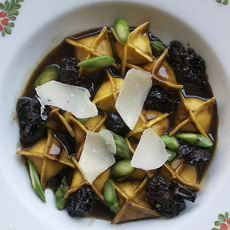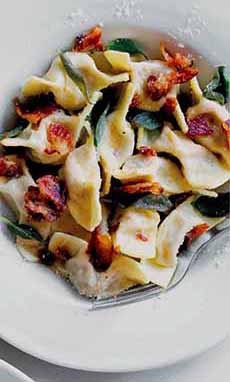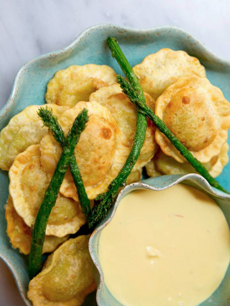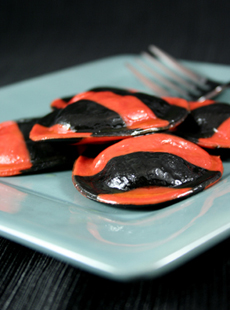FOOD HOLIDAY: The History Of Ravioli For National Ravioli Day
 [1] A classic dish of ravioli with tomato sauce (photo © CB Crabcakes).
|
When we were growing up, our mom had access to an Italian restaurant supply store, from which she purchased copious amounts of ravioli: in pinked but uncut sheets, four layers to a cardboard carton. When tossed into boiling water and they’d magically separate for an brief swim, until ready to drain and sauce. Each week we had Ravioli Night. In those days it was meat or cheese with Mom’s homemade pasta sauce. Lobster ravioli, pumpkin ravioli, and even spinach ravioli were still in the future. She did, however, have a wedge of Parmesan cheese, which she grated over our dishes. There has always been ravioli in our life. But who invented ravioli? China gets the credit for inventing not only strand pasta—thin chow mein noodles like Italian angel hair, thin wonton noodles like Italian linguine, lo mein noodles like Italian pappardelle, and wide wonton noodles like Italian fettuccine—but filled pasta. Those stuffed wontons (boiled in soup or steamed separately) or pot stickers (pan-fried) wrapped wheat dough around a filling. Other Asian countries followed suit, and also made pasta from rice and from mung bean threads. When it arrived Italy, stuffed pasta was called ravioli (another name is pillow pasta). Some food historians believe the name derives from the old Italian word riavvolgere, to wrap. Others believe that the dish was named after a renowned 13th-century chef by that name, who lived in what is now the Italian region of Liguria), who is credited with the invention of the dumpling composed of two layers of thin pasta dough with a filling sealed between them. Today, you can find pasta shaped in circles, novelty shapes (fish, hearts, stars, etc.), rectangles, squares, triangles and other shapes. But let’s start at the beginning. Many have credited Marco Polo, who returned from China in 1295 after 17 years of service in Kublai Khan’s court. He brought a form of what is now called pillow pasta, like stuffed wontons. But more recent archeological discoveries in Southern Italy have uncovered examples of square ravioli dating to the 9th century. Pasta initially arrived in Italy during the Arab conquests of Sicily in the 9th century. Traders brought pasta back from China. The form of pasta they brought back was what is now our iconic Italian food (via Arabia via China), spaghetti. Of course, in those days communications weren’t great over large distances, and it could be that the Venetians didn’t know about stuffed pasta until Marco Polo returned. Like the Chinese, Italians served ravioli (singular: raviolo) in broth, or with a pasta sauce—oil- or cream-based. Tomatoes, which arrived from the New World in the late 16th century, were used as houseplants, believed to be poisonous, and not eaten in Italy until the 18th century. By the 14th century, all kinds of pasta ripiena (filled pasta) began to appear throughout Italy. Each region would fill them with local ingredients and give them local names. The creative chefs of wealthy families expanded on the square ravioli idea shape to circles, half-moons, hats and other shapes, creating agnolotti, cappelletti, tortelli, tortellini, tortelloni and a host of other shapes. Affordable by all economic classes, stuffed pasta grew in popularity during the Middle Ages. A bottom sheet of dough was dotted with filling, the top sheet added and the individual pillows scored and crimped. Fillings could include: Emilia-Romagna, called “the capital of filled pasta” by some, served tortellini (also called cappelletti or tortelli) in beef or capon broth. Other preparations included meat sauce (ragù alla Bolognese) and fresh cream with Parmigiano-Reggiano. Traditional fillings were mortadella or prosciutto with Parmigiano, nutmeg and pepper. Here are some of the numerous specialties from other regions: They were molded to resemble the tip of a stalk of wheat (photo #5), boiled and served—these days, with a fresh tomato and basil sauce. In Sardinia, the local aged pecorino is shaved on top instead of the Parmigiano of the continent. A variation of the filling uses fresh (day old) pecorino cheese, mashed potatoes and mint, onions or oregano. Until the 16th century, pasta of all types was customarily served with a sweet accent—crumbled amaretti biscotti, currants, marmalade and/or sweet spices (cinnamon, ginger, nutmeg). These ingredients could also be added to the filling (see photo #8 for a chocolate ravioli recipe). While cooking in broth was a common preparation, the ravioli could be fried and served with spices, sugar or honey. But today, full-fledged dessert ravioli is available, from chocolate and vanilla dough to fillings of chestnut, chocolate, fruit and tiramisu. We even have a recipe for peanut butter and jelly ravioli. And there’s no end in sight. Many thanks to Piergiorgio and Amy Nicoletti for their scholarship on the history of ravioli. |
|
|
|
||









